by NEIL SINYARD
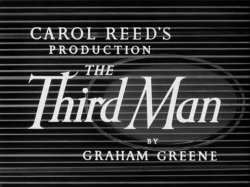 To commemorate the 70th anniversary of the release of Carol Reed’s The Third Man and the 20th anniversary of its being voted the best British film of the century in a British Film Institute poll, I want to offer some reflections on the film and particularly on the character of Harry Lime, who, as played by Orson Welles, is assuredly one of the cinema’s most charismatic villains. A remarkable aspect of Lime’s cinematic durability is that he is only on screen for around 8 minutes or so. My focus will be on those scenes in which he appears and the reasons for their impact. To begin with, however, I wish to ruminate on one of his most striking features: his name.
To commemorate the 70th anniversary of the release of Carol Reed’s The Third Man and the 20th anniversary of its being voted the best British film of the century in a British Film Institute poll, I want to offer some reflections on the film and particularly on the character of Harry Lime, who, as played by Orson Welles, is assuredly one of the cinema’s most charismatic villains. A remarkable aspect of Lime’s cinematic durability is that he is only on screen for around 8 minutes or so. My focus will be on those scenes in which he appears and the reasons for their impact. To begin with, however, I wish to ruminate on one of his most striking features: his name.
What’s in a name?
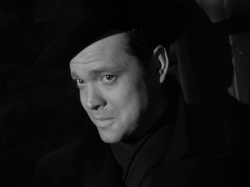 In Ways of Escape, Graham Greene mentioned some of the symbolic interpretations which had been offered about the names of the two main characters of his screenplay, Harry Lime and Holly Martins: for example, how the former had been linked to the lime tree in Sir James Frazer’s classic study of pagan mythology, The Golden Bough (1922), and how Holly was clearly associated with Christmas, so symbolically they represented a clash between paganism and Christianity. Greene could offer a much simpler explanation for what he had in mind:
In Ways of Escape, Graham Greene mentioned some of the symbolic interpretations which had been offered about the names of the two main characters of his screenplay, Harry Lime and Holly Martins: for example, how the former had been linked to the lime tree in Sir James Frazer’s classic study of pagan mythology, The Golden Bough (1922), and how Holly was clearly associated with Christmas, so symbolically they represented a clash between paganism and Christianity. Greene could offer a much simpler explanation for what he had in mind:
The truth is I wanted for my ‘villain’ a name natural and yet disagreeable, and to me Lime represented the quicklime in which murderers were said to be buried. As for Holly, it was because my first choice of name Rollo had not met with the approval of Joseph Cotten. So much for symbols.1
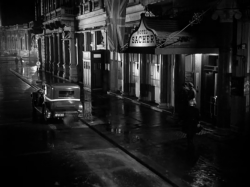 However, it is worth noting that a character’s name in The Third Man, like his or her nationality, is a very slippery business in what is an extremely slippery film (in terms of its narrative development, its camera style, and even its streets, which seem to gleam with wetness although it never rains). Holly was originally Rollo but is sometimes called Harry by Anna Schmidt (Alida Valli), who is supposedly Austrian but is actually Czech, so one could surmise that Schmidt is not her real name.
However, it is worth noting that a character’s name in The Third Man, like his or her nationality, is a very slippery business in what is an extremely slippery film (in terms of its narrative development, its camera style, and even its streets, which seem to gleam with wetness although it never rains). Holly was originally Rollo but is sometimes called Harry by Anna Schmidt (Alida Valli), who is supposedly Austrian but is actually Czech, so one could surmise that Schmidt is not her real name.
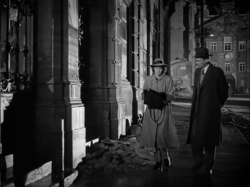
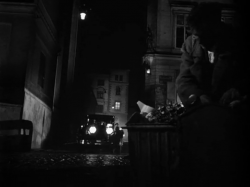 The British Chief of Police, Major Calloway (Trevor Howard) is mistakenly called Callahan by Holly (the name probably derives from the head of the British Military Police at that time, Galloway) but Calloway is also the name of the crooked financier of one of Greene’s short stories ‘Across the Bridge’ (1938) which concludes with one of his most potent phrases – “the baseless optimism that is worse than hopeless despair” – which seems to predict the folly of appeasement and the onset of war. In The Third Man, we are amidst the rubble of Vienna after World War Two, and Holly will encounter a sinister Austrian doctor called Dr Winkle (Erich Ponto) whose name Holly will mispronounce as “winkle”. The film is a veritable miasma of unstable identity in a city of fluid nationalities and borders and even more flexible morality. As one of Lime’s shady associates, ‘Baron’ Kurtz (Ernst Deutsch), tells Holly: “I tell you, I have done things that would have been unthinkable before the war.”
The British Chief of Police, Major Calloway (Trevor Howard) is mistakenly called Callahan by Holly (the name probably derives from the head of the British Military Police at that time, Galloway) but Calloway is also the name of the crooked financier of one of Greene’s short stories ‘Across the Bridge’ (1938) which concludes with one of his most potent phrases – “the baseless optimism that is worse than hopeless despair” – which seems to predict the folly of appeasement and the onset of war. In The Third Man, we are amidst the rubble of Vienna after World War Two, and Holly will encounter a sinister Austrian doctor called Dr Winkle (Erich Ponto) whose name Holly will mispronounce as “winkle”. The film is a veritable miasma of unstable identity in a city of fluid nationalities and borders and even more flexible morality. As one of Lime’s shady associates, ‘Baron’ Kurtz (Ernst Deutsch), tells Holly: “I tell you, I have done things that would have been unthinkable before the war.”
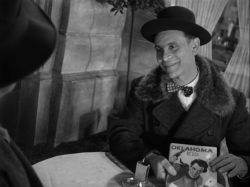
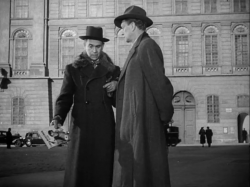 Although Greene indicated that the name of Holly for his main character was inspired by the 19th century American poet Thomas Holley Chivers, who was essentially a figure of fun (Greene wanted the name to be absurd and at one stage Anna comments directly on how silly it is), it has been suggested that the actual character of Holly Martins was based on the American screenwriter and producer Robert Buckner as an act of retaliation for Buckner’s screen adaptation of Greene’s novel The Confidential Agent, which had been filmed by Herman Shumlin in 1945. Buckner had been the screenwriter on a number of westerns, including The Oklahoma Kid (1939), and Holly Martins writes westerns, one of which is called ‘Oklahoma Kid’, which ‘Baron’ Kurtz displays on his first meeting with him and which Major Calloway later tells Holly he has read with some pleasure. Greene might have been having a private joke at Buckner’s expense (he was a great practical joker), but I don’t think he was after revenge. After all, he rallied to the defence of Lauren Bacall’s much-criticised performance in that film, and in general thought The Confidential Agent perhaps the best American film adaptation of his work, far surpassing the endeavours of more prestigious Hollywood directors, such as Fritz Lang (Ministry of Fear (1944)) John Ford (The Fugitive (1947), based on The Power and the Glory), Joseph L. Mankiewicz (The Quiet American (1958)) and George Cukor (Travels with my Aunt (1972)). He might also have been pondering ‘Holly’ as a diminutive of ‘Hollywood’, and thinking wryly of those bizarre story conferences about The Third Man that he and Carol Reed had shared with Hollywood mogul, David O Selznick, which on one occasion seemed destined to be endlessly protracted until Selznick realised he was thinking of another film entirely. In his Preface to The Pleasure Dome (1972) Greene recalled, among other things, Selznick’s dislike of the film’s title (“Who the hell is going to a film called The Third Man?” he grumbled), and his preferred choice of Noel Coward in the role of Harry Lime (both Reed and Greene were appalled).2
Although Greene indicated that the name of Holly for his main character was inspired by the 19th century American poet Thomas Holley Chivers, who was essentially a figure of fun (Greene wanted the name to be absurd and at one stage Anna comments directly on how silly it is), it has been suggested that the actual character of Holly Martins was based on the American screenwriter and producer Robert Buckner as an act of retaliation for Buckner’s screen adaptation of Greene’s novel The Confidential Agent, which had been filmed by Herman Shumlin in 1945. Buckner had been the screenwriter on a number of westerns, including The Oklahoma Kid (1939), and Holly Martins writes westerns, one of which is called ‘Oklahoma Kid’, which ‘Baron’ Kurtz displays on his first meeting with him and which Major Calloway later tells Holly he has read with some pleasure. Greene might have been having a private joke at Buckner’s expense (he was a great practical joker), but I don’t think he was after revenge. After all, he rallied to the defence of Lauren Bacall’s much-criticised performance in that film, and in general thought The Confidential Agent perhaps the best American film adaptation of his work, far surpassing the endeavours of more prestigious Hollywood directors, such as Fritz Lang (Ministry of Fear (1944)) John Ford (The Fugitive (1947), based on The Power and the Glory), Joseph L. Mankiewicz (The Quiet American (1958)) and George Cukor (Travels with my Aunt (1972)). He might also have been pondering ‘Holly’ as a diminutive of ‘Hollywood’, and thinking wryly of those bizarre story conferences about The Third Man that he and Carol Reed had shared with Hollywood mogul, David O Selznick, which on one occasion seemed destined to be endlessly protracted until Selznick realised he was thinking of another film entirely. In his Preface to The Pleasure Dome (1972) Greene recalled, among other things, Selznick’s dislike of the film’s title (“Who the hell is going to a film called The Third Man?” he grumbled), and his preferred choice of Noel Coward in the role of Harry Lime (both Reed and Greene were appalled).2
But what about the name ‘Harry Lime’? ‘Harry’ is a good English name with Shakespearean connections (“Pray God for Harry, England and St George!”), but it also has connotations of to ‘harry’, as in ‘harass’, or ‘hurry’, for a character who is elusive, sometimes threatening, and always on the move. Lime is a shade of green, or what Peter Conrad called “an acid variant of the novelist’s name.”3 Another connection between Greene and Lime is obliquely suggested by an interesting comment about the novelist which is cited in Ian Thomson’s book Articles of Faith, where Tom Burns is quoted as saying that, when Greene entered a room, he “seemed to me to have a spotlight on him”.4 Think of Harry Lime’s first entrance in The Third Man: arguably the most dramatic spotlit entrance of any film character.
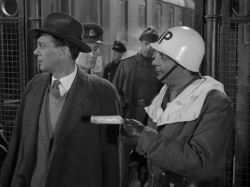 The name resonates in other ways. It is only one letter short of ‘smile’; and he is the only character in the whole film who really smiles. (When anyone else does, or laughs, it is so remarkable an occurrence that it usually attracts comment. Anna has only two laughs in her, she says; and Holly seems almost terminally morose, a potentially monotonous mood which, it should be said, Joseph Cotten invests with a good deal of variety and charm.) ‘Lime’ is also only one letter short of ‘slime’, as if presaging that final chase in the sewers. It is a clever name because it is such a fizzy concoction of ‘sly’, ‘slime’, ‘smile’ and ‘lie’, all of which make up the cocktail of his character. And the film certainly ensures that we don’t forget it, or him: the name is mentioned twice in the prologue, and ten times in the opening ten minutes, and he dominates every scene in the picture, whether he is in it or not. His absence is always present; indeed it ensures the film always seems to have a spring in its step and a surprise round every corner. “Lime, Harry Lime,” says Holly in the opening scene when he gets off the train and is explaining the purpose of his visit to Vienna, “Thought he’d be here to meet me.” But he isn’t, for Lime is a will o’ the wisp who is not where Holly thought he would be nor is he where Calloway thinks he is. “Could you tell me.. is this …?” says Holly at the graveyard when wondering whose funeral service it is “A fellow called Lime”, says Calloway, dispassionately. But it is not quite, for someone else is in that coffin; although even when he is supposed to be dead, his spirit seems to walk abroad and every character seems obsessed with him.
The name resonates in other ways. It is only one letter short of ‘smile’; and he is the only character in the whole film who really smiles. (When anyone else does, or laughs, it is so remarkable an occurrence that it usually attracts comment. Anna has only two laughs in her, she says; and Holly seems almost terminally morose, a potentially monotonous mood which, it should be said, Joseph Cotten invests with a good deal of variety and charm.) ‘Lime’ is also only one letter short of ‘slime’, as if presaging that final chase in the sewers. It is a clever name because it is such a fizzy concoction of ‘sly’, ‘slime’, ‘smile’ and ‘lie’, all of which make up the cocktail of his character. And the film certainly ensures that we don’t forget it, or him: the name is mentioned twice in the prologue, and ten times in the opening ten minutes, and he dominates every scene in the picture, whether he is in it or not. His absence is always present; indeed it ensures the film always seems to have a spring in its step and a surprise round every corner. “Lime, Harry Lime,” says Holly in the opening scene when he gets off the train and is explaining the purpose of his visit to Vienna, “Thought he’d be here to meet me.” But he isn’t, for Lime is a will o’ the wisp who is not where Holly thought he would be nor is he where Calloway thinks he is. “Could you tell me.. is this …?” says Holly at the graveyard when wondering whose funeral service it is “A fellow called Lime”, says Calloway, dispassionately. But it is not quite, for someone else is in that coffin; although even when he is supposed to be dead, his spirit seems to walk abroad and every character seems obsessed with him.
All of this mystery and mythologizing is setting the makers of the film a huge challenge, because when he does eventually appear, it must deliver on that promise. It is similar to a Hitchcock suspense sequence: when you have worked an audience up to such a pitch of expectation, you have to top that expectation with something extra in order to avoid anti-climax. After all, an audience knows that Orson Welles will appear sometime in the film, because his name is on the credits. When Carol Reed told Welles apologetically that he would not appear until halfway through, Welles replied: “Could you make it two-thirds?” He might well have been thinking of something like the carefully delayed entrance for maximum effect of the character of Kurtz in Joseph Conrad’s novella, Heart of Darkness, a work very close to Welles’s own heart (he had adapted it for radio, and it was intended to be his first film before location and financial complications forced its cancellation: nevertheless, Citizen Kane was to show clear traces of its influence.)5 And it is not just a case of when the character is going to appear; it is also how.
Extract 1: Enter Harry Lime
This is surely one of the classic moments of the cinema: once seen, never forgotten. Much of its power derives from the skill of its preparation.
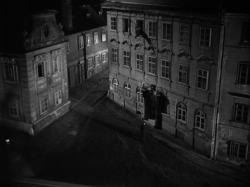 As Anna and the lovelorn and inebriated Holly are sharing their memories of Harry in Anna’s apartment, the camera, which has been behaving oddly throughout the film, makes a sudden lunge towards the open window, as if it has spotted something strange out in the square that it was not expecting to see. A dark figure is walking across the street but it seems to stop as if noting a light on in Anna’s apartment. The cat, which Anna has said only liked Harry, has gone wandering off into the square to see what is happening. (One is not surprised to find that Harry was a cat person – sly, self-sufficient, a loner – whereas Holly is associated with a squawking parrot.) It comes to a doorway and starts sniffing round a person’s shoes, which are well polished and give the impression of a man who is doing quite well for himself for someone in a bombed out city. Another thing about those shoes: they might give a clue as to the identity of the murderer of the porter (Paul Hoerbiger), who just, before his death, looked as if he had seen a ghost. The screenplay reads: “Porter slams the window and turns towards camera. He stays still, listening. The sound of squeaking shoes [my emphasis] approaching from the next room. As they come closer, there is a look of horror on the Porter’s face.”6 Holly will be suspected of that murder; and it could be another example of Holly’s getting into a scrape from which his best friend has escaped, a repeated pattern of their childhood friendship.
As Anna and the lovelorn and inebriated Holly are sharing their memories of Harry in Anna’s apartment, the camera, which has been behaving oddly throughout the film, makes a sudden lunge towards the open window, as if it has spotted something strange out in the square that it was not expecting to see. A dark figure is walking across the street but it seems to stop as if noting a light on in Anna’s apartment. The cat, which Anna has said only liked Harry, has gone wandering off into the square to see what is happening. (One is not surprised to find that Harry was a cat person – sly, self-sufficient, a loner – whereas Holly is associated with a squawking parrot.) It comes to a doorway and starts sniffing round a person’s shoes, which are well polished and give the impression of a man who is doing quite well for himself for someone in a bombed out city. Another thing about those shoes: they might give a clue as to the identity of the murderer of the porter (Paul Hoerbiger), who just, before his death, looked as if he had seen a ghost. The screenplay reads: “Porter slams the window and turns towards camera. He stays still, listening. The sound of squeaking shoes [my emphasis] approaching from the next room. As they come closer, there is a look of horror on the Porter’s face.”6 Holly will be suspected of that murder; and it could be another example of Holly’s getting into a scrape from which his best friend has escaped, a repeated pattern of their childhood friendship.
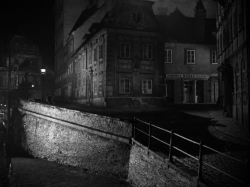
 When Holly comes out of Anna’s apartment, he notices a figure in shadow in a doorway across the square. Still quite drunk, he starts shouting at it: “Cat got your tongue?” and then defiantly initiates a game with this mysterious spy: “Come out, come out, whoever you are…” Suddenly this childish chant seems magically to summon up the very person who has defined childhood for him. Joseph Cotten’s reaction shot at that point is superb, for the shock of what he sees jerks him forward, and what will follow in a moment is what Graham Greene said was his favourite game from childhood: a game of hide-and-seek in the dark. The game has cropped up also in The Fallen Idol (1948) and in his short story ‘The End of the Party’ and in each case the game will start playfully but will turn into something much more serious, as it will in The Third Man, when the game is to be played out again in earnest and fatally in the sewers of Vienna.
When Holly comes out of Anna’s apartment, he notices a figure in shadow in a doorway across the square. Still quite drunk, he starts shouting at it: “Cat got your tongue?” and then defiantly initiates a game with this mysterious spy: “Come out, come out, whoever you are…” Suddenly this childish chant seems magically to summon up the very person who has defined childhood for him. Joseph Cotten’s reaction shot at that point is superb, for the shock of what he sees jerks him forward, and what will follow in a moment is what Graham Greene said was his favourite game from childhood: a game of hide-and-seek in the dark. The game has cropped up also in The Fallen Idol (1948) and in his short story ‘The End of the Party’ and in each case the game will start playfully but will turn into something much more serious, as it will in The Third Man, when the game is to be played out again in earnest and fatally in the sewers of Vienna.
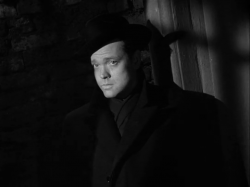 The revelation is visually stunning. One of the neighbours, complaining about the noise in the street, opens her window and the light from her room illuminates the doorway like a theatrical spotlight, to reveal Harry Lime, an appropriately grand entrance for a larger-than-life character who, it seems, even has his own theme tune and one which is so insistently catchy that it sold 40 million copies on its release. Anton Karas’s music is one of the film’s master-strokes (there are a few) and part of its magic is that it fits the character so snugly. There is a hollowness to it, as if it is suggesting that Harry, like Conrad’s Kurtz, is hollow at the core, yet its jauntiness has something of Harry’s cheek; it is not the obvious music for a villain; it seems to invite us to forgive him. Incidentally it is quite wrong to claim, as some soundtrack critics have done, that the theme is repeated incessantly through the film. Apart from the opening credits, it only appears when Harry appears.
The revelation is visually stunning. One of the neighbours, complaining about the noise in the street, opens her window and the light from her room illuminates the doorway like a theatrical spotlight, to reveal Harry Lime, an appropriately grand entrance for a larger-than-life character who, it seems, even has his own theme tune and one which is so insistently catchy that it sold 40 million copies on its release. Anton Karas’s music is one of the film’s master-strokes (there are a few) and part of its magic is that it fits the character so snugly. There is a hollowness to it, as if it is suggesting that Harry, like Conrad’s Kurtz, is hollow at the core, yet its jauntiness has something of Harry’s cheek; it is not the obvious music for a villain; it seems to invite us to forgive him. Incidentally it is quite wrong to claim, as some soundtrack critics have done, that the theme is repeated incessantly through the film. Apart from the opening credits, it only appears when Harry appears.
In the published screenplay, Greene describes Lime’s habitual expression in Martins’ presence as one of “amused geniality, a recognition that his happiness will make the world’s day.”7 That could almost have been written with Welles in mind. It is as if his cockeyed smile, the ironical twinkle in his eye, his cheerful rascality, requires the tilting of the camera to reflect Harry’s sardonic take on things.8 Even the step where he stands seems to be on a slight slope. In Citizen Kane, there is a famous close-up of Welles when the young Kane as newspaper editor has just enunciated his ‘Declaration of Principles’, and Joseph Cotten as his best friend Leland asks to keep a copy of it as he feels it might someday be important. Welles as Kane smiles at that but looks uncomfortable, as if he has been caught out at something. Peter Bogdanovich thought the shot looked awkward, though Welles always insisted it was meant to look that way, but the close-up in The Third Man cannot be faulted: it is exactly what the moment demands. The great French critic André Bazin thought this performance enshrined Welles as a movie actor much more than Citizen Kane. This is all the more remarkable given its short duration, and is particularly interesting because, unusually for Welles, he played the part without make-up, meaning that this was the closest we ever got to him on screen. Bazin went on:
The topicality of Greene’s script equated the ambiguity of his hero with our war-torn world. Personable bandit, in tune with the disillusionment, the romanticism of the period, archangel of the sewers, an outlaw prowling the zone dividing good from evil, a monster worthy of love, Harry Lime/Welles was, in this case, more than a character: he was a myth.9
Personable bandit/monster worthy of love: Bazin’s paradoxical description of Lime cannot but remind one of those favourite lines of Greene’s in Robert Browning’s dramatic monologue, Bishop Blougram’s Apology, which Greene said could stand as an epigraph to all his books:
Our interest’s on the dangerous edge of things,
The honest thief, the tender murderer,
The superstitious atheist, demi-rep
That loves and saves her soul in new French books –
We watch while these in equilibrium keep
The giddy line midway.10
Small wonder that Harry Lime appealed so strongly to Greene’s imagination. Little wonder also that Carol Reed was his favourite of all the directors he worked with, not simply fulfilling his vision of this moment but imaginatively enhancing it.
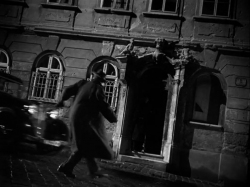 There is a fine touch still to come. When Holly tries to cross the square, he is almost run over; and in the time it takes him to recover, Lime has gone. It is a subliminal recollection of how Lime is supposed to have died (being hit by a car), but he seems to have disappeared as if by magic. We remember that Lime has taught Holly the three-card trick, and also perhaps that Orson Welles was an accomplished magician who could no doubt make himself disappear in a deserted square. It is another example of why Welles was such perfect casting.
There is a fine touch still to come. When Holly tries to cross the square, he is almost run over; and in the time it takes him to recover, Lime has gone. It is a subliminal recollection of how Lime is supposed to have died (being hit by a car), but he seems to have disappeared as if by magic. We remember that Lime has taught Holly the three-card trick, and also perhaps that Orson Welles was an accomplished magician who could no doubt make himself disappear in a deserted square. It is another example of why Welles was such perfect casting.
As yet, we have only seen Harry Lime. We have heard much about him – the worst racketeer in Vienna, fun to be around – but we have not heard his voice. From a brilliantly constructed visual sequence, we will move to what one could equally be described as an exemplary piece of screenwriting, where the eloquence of the dialogue and the sharpness of the characterisation never get in the way of purposefully moving the film forward.
Extract 2: The Great Wheel
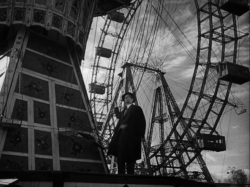 The scene on the Great Wheel is so important because it is the only one in the entire film between Harry and Holly. In those five minutes the momentum of the narrative has to be maintained, but the scene must also capture the essential relationship between the two men, which is the core of the film and what has kept Holly in Vienna. If that does not come across, the whole film falls apart.
The scene on the Great Wheel is so important because it is the only one in the entire film between Harry and Holly. In those five minutes the momentum of the narrative has to be maintained, but the scene must also capture the essential relationship between the two men, which is the core of the film and what has kept Holly in Vienna. If that does not come across, the whole film falls apart.
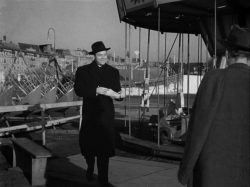 There is an immediate contrast in character: Holly waiting glumly, Harry arriving on the move- brisk, unapologetic, already smiling, no explanations, just a greeting (“Hello, old man…”). There is no suggestion of guilt. He does not suffer from a bad conscience, only from bad indigestion (rather like the lawyer Prewitt in Greene’s Brighton Rock, who is also corrupt and dyspeptic and who says that “I’ve sunk so deep I carry the secrets of the sewer”: Harry Lime has taken that one literal stage further). Yet immediately on his appearance, and even as Harry circles round him (he could always run rings round Holly), one can feel life quickening with excitement for Holly and can sense within him the magnetism of Harry’s attraction.
There is an immediate contrast in character: Holly waiting glumly, Harry arriving on the move- brisk, unapologetic, already smiling, no explanations, just a greeting (“Hello, old man…”). There is no suggestion of guilt. He does not suffer from a bad conscience, only from bad indigestion (rather like the lawyer Prewitt in Greene’s Brighton Rock, who is also corrupt and dyspeptic and who says that “I’ve sunk so deep I carry the secrets of the sewer”: Harry Lime has taken that one literal stage further). Yet immediately on his appearance, and even as Harry circles round him (he could always run rings round Holly), one can feel life quickening with excitement for Holly and can sense within him the magnetism of Harry’s attraction.
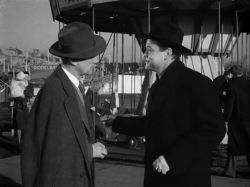 “Hello, old man” is a slightly odd greeting, a term of endearment (he uses it six times in the scene) that is not meant literally but does carry certain inferences. There is still an element of the naughty boy about Harry Lime. “He never grew up,” Anna has said about him, “the world grew up around him.” Holly seems older by comparison, having the melancholy of maturity. The setting adds to that feeling: a playground, a fun fair out of season; and in this context, one might also think back to the little boy Hansl (Herbert Halbik) with the round chubby cheeks, whose whole purpose in the film seems to be to get Holly into trouble and who is surely meant as a sort of surrogate of what Harry was like as a child and his relationship even then with Holly. The phrase “old man” also suggests to me a comparison with a film made the previous year, John Huston’s Key Largo (1948), another allegorical fable about the post-war situation, with Edward G Robinson as Johnny Rocco, a deported gangster in hiding, planning a return to America by flooding it not with diluted penicillin (which is Harry’s racket) but with counterfeit money. “Who’s gonna stop me, old man?” he says to Lionel Barrymore, who is in a wheelchair and who symbolically, I think, is meant to evoke Roosevelt. There the phrase “old man” is literal and said with a sneer, unlike the affectionate address of Harry, but the underlying sentiment is similar. Barrymore in Key Largo and Holly in The Third Man are ‘old men’ in comparison with their audacious adversaries, or, more specifically, old-fashioned men, dinosaurs of decency out of place in the ruthless new world of pragmatism, profit and power.
“Hello, old man” is a slightly odd greeting, a term of endearment (he uses it six times in the scene) that is not meant literally but does carry certain inferences. There is still an element of the naughty boy about Harry Lime. “He never grew up,” Anna has said about him, “the world grew up around him.” Holly seems older by comparison, having the melancholy of maturity. The setting adds to that feeling: a playground, a fun fair out of season; and in this context, one might also think back to the little boy Hansl (Herbert Halbik) with the round chubby cheeks, whose whole purpose in the film seems to be to get Holly into trouble and who is surely meant as a sort of surrogate of what Harry was like as a child and his relationship even then with Holly. The phrase “old man” also suggests to me a comparison with a film made the previous year, John Huston’s Key Largo (1948), another allegorical fable about the post-war situation, with Edward G Robinson as Johnny Rocco, a deported gangster in hiding, planning a return to America by flooding it not with diluted penicillin (which is Harry’s racket) but with counterfeit money. “Who’s gonna stop me, old man?” he says to Lionel Barrymore, who is in a wheelchair and who symbolically, I think, is meant to evoke Roosevelt. There the phrase “old man” is literal and said with a sneer, unlike the affectionate address of Harry, but the underlying sentiment is similar. Barrymore in Key Largo and Holly in The Third Man are ‘old men’ in comparison with their audacious adversaries, or, more specifically, old-fashioned men, dinosaurs of decency out of place in the ruthless new world of pragmatism, profit and power.
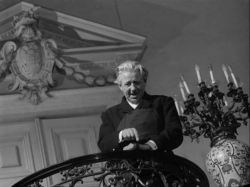 The Great Wheel is an inspired choice of location. It is a reminder of the old Europe which the recent war has destroyed. It is also appropriate for a film of constant instability and revolving perspectives. Anna tells Calloway at one stage that “You’ve got things upside down”, and when the porter tells Holly about Harry’s funeral and the destination of the dead body, he points upwards to indicate Hell and down to indicate Heaven. In his 1947 essay ‘The Lost Childhood’ (which would be a good alternative title for the film), Greene writes that, inspired by Marjorie Bowen’s novel, The Viper of Milan, he had discovered the pattern for his future work, which was: “perfect evil walking the world where perfect good can never walk again, and only the pendulum ensures that after all in the end justice is done.”11 It seems to me that The Third Man is an elaboration of that pattern, with Lime as a charismatic Lucifer, who insists that he still believes in God but who knows the way the world is turning. The sin of Lucifer was pride, which comes before a fall, and Harry Lime’s fall will be precipitous: from the top of the Great Wheel all the way to the sewers. As Calloway said on discovering that the man they buried at the beginning of the film was not Lime: “We should have dug deeper than a grave.”
The Great Wheel is an inspired choice of location. It is a reminder of the old Europe which the recent war has destroyed. It is also appropriate for a film of constant instability and revolving perspectives. Anna tells Calloway at one stage that “You’ve got things upside down”, and when the porter tells Holly about Harry’s funeral and the destination of the dead body, he points upwards to indicate Hell and down to indicate Heaven. In his 1947 essay ‘The Lost Childhood’ (which would be a good alternative title for the film), Greene writes that, inspired by Marjorie Bowen’s novel, The Viper of Milan, he had discovered the pattern for his future work, which was: “perfect evil walking the world where perfect good can never walk again, and only the pendulum ensures that after all in the end justice is done.”11 It seems to me that The Third Man is an elaboration of that pattern, with Lime as a charismatic Lucifer, who insists that he still believes in God but who knows the way the world is turning. The sin of Lucifer was pride, which comes before a fall, and Harry Lime’s fall will be precipitous: from the top of the Great Wheel all the way to the sewers. As Calloway said on discovering that the man they buried at the beginning of the film was not Lime: “We should have dug deeper than a grave.”
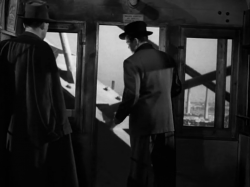 “Have you ever seen any of your victims?” Holly has asked Harry, referring to the patients who have suffered from taking the diluted penicillin. (And, incidentally, the turning-point for Holly is the later occasion when Calloway tricks him into visiting the children’s hospital and he sees for himself some of the victims of Harry’s racket.) In response, Harry will nonchalantly deliver the first of two statements of personal philosophy which encapsulate the moral deformities of a fallen post-war world. “Victims?” he says. “Don’t be melodramatic.” Opening the door to the cable car to look down at humanity below, he goes on:
“Have you ever seen any of your victims?” Holly has asked Harry, referring to the patients who have suffered from taking the diluted penicillin. (And, incidentally, the turning-point for Holly is the later occasion when Calloway tricks him into visiting the children’s hospital and he sees for himself some of the victims of Harry’s racket.) In response, Harry will nonchalantly deliver the first of two statements of personal philosophy which encapsulate the moral deformities of a fallen post-war world. “Victims?” he says. “Don’t be melodramatic.” Opening the door to the cable car to look down at humanity below, he goes on:
Look down there. Would you really feel any pity if one of those dots stopped moving forever? If I said you could have twenty thousand pounds for every dot that stops, would you really, old man, tell me to keep my money – or would you calculate how many dots you could afford to spare? Free of income tax, old man, free of income tax.
A moment later he will go on to say:
In these days, old man, nobody thinks of human beings. Governments don’t, so why should we? They talk about the people and the proletariat, and I talk about the suckers and the mugs, it’s the same thing. They have their 5-year plans; so have I….
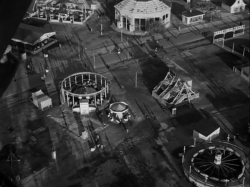 Harry’s smooth alignment of his own individual philosophy with the political morality of the day is still capable of chilling the blood. From his vantage-point of superiority, Harry has the dangerous egotism of the demagogue, an attitude that has accounted for the current devastation of Europe. In Harry’s eyes, such cheerful cynicism is not an erosion of the soul but a recognition of the new reality. It could not be more different from the naive simplicities of Holly’s western novels where good will always triumph and evil will always be defeated.
Harry’s smooth alignment of his own individual philosophy with the political morality of the day is still capable of chilling the blood. From his vantage-point of superiority, Harry has the dangerous egotism of the demagogue, an attitude that has accounted for the current devastation of Europe. In Harry’s eyes, such cheerful cynicism is not an erosion of the soul but a recognition of the new reality. It could not be more different from the naive simplicities of Holly’s western novels where good will always triumph and evil will always be defeated.
As if delighting in his amorality, Harry starts teasing Holly with a little game of his own, which typically Holly does not quite grasp. “There’s no proof against me. Except you,” Harry says and muses how easily Holly could now be disposed of. “Don’t be too sure,” says Holly with grim apprehension but Harry seems still to be turning the idea over in his mind. “Hm… I carry a gun. Don’t think they’d look for a bullet after you hit that ground.” And then he laughs: “I suppose he was laughing at us all the time,” Anna has said of him. He has been pulling Holly’s leg, of course, for, as he says, “as though I’d do anything to you or you to me.” Inadvertently he reveals his Achilles’ heel.
The cuckoo clock
 As he gets out of the car, Harry extends his offer to Holly to come in with him as a partner and set up another meeting, adding that “when we do meet, old man, it’s you I want to see, not the police.” And then comes the parting shot. “And don’t be so gloomy,” he says. “After all, it’s not that awful. You know what the fellow said, in Italy for thirty years under the Borgias, they had warfare, terror, murder, bloodshed – they produced Michaelangelo, Leonardo da Vinci and the Renaissance. In Switzerland, they had brotherly love, five hundred years of democracy and peace, and what did that produce? The cuckoo clock. So long, Holly.” It is the one part of the scene not written by Graham Greene, but improvised on the spot by Orson Welles, and it is an improvisation of genius. Throughout the scene, his delivery of the dialogue – the timing, the rhythm, the apparent spontaneity, the irresistible shafts of mischief, the way he seems always two sentences ahead of Holly’s laborious thought processes – has been instrumental in lifting the words off the page. That exit speech – witty, paradoxical, sardonic, and, as enunciated by Welles, a marvel of breath control and ironic inflection – elevates the scene onto another level. Supreme man of the theatre that he was, Welles knew that a character who had been given such a stunning entrance would need an equally inspired exit, because, to all intents and purposes, this is his last line in the film. What is wonderful about it is that is perfectly in character. It is a lot more than an afterthought by an egotistical actor; it is the magical something extra that makes a screen character not simply memorable but immortal and makes a film sequence not just exceptional but unforgettable.
As he gets out of the car, Harry extends his offer to Holly to come in with him as a partner and set up another meeting, adding that “when we do meet, old man, it’s you I want to see, not the police.” And then comes the parting shot. “And don’t be so gloomy,” he says. “After all, it’s not that awful. You know what the fellow said, in Italy for thirty years under the Borgias, they had warfare, terror, murder, bloodshed – they produced Michaelangelo, Leonardo da Vinci and the Renaissance. In Switzerland, they had brotherly love, five hundred years of democracy and peace, and what did that produce? The cuckoo clock. So long, Holly.” It is the one part of the scene not written by Graham Greene, but improvised on the spot by Orson Welles, and it is an improvisation of genius. Throughout the scene, his delivery of the dialogue – the timing, the rhythm, the apparent spontaneity, the irresistible shafts of mischief, the way he seems always two sentences ahead of Holly’s laborious thought processes – has been instrumental in lifting the words off the page. That exit speech – witty, paradoxical, sardonic, and, as enunciated by Welles, a marvel of breath control and ironic inflection – elevates the scene onto another level. Supreme man of the theatre that he was, Welles knew that a character who had been given such a stunning entrance would need an equally inspired exit, because, to all intents and purposes, this is his last line in the film. What is wonderful about it is that is perfectly in character. It is a lot more than an afterthought by an egotistical actor; it is the magical something extra that makes a screen character not simply memorable but immortal and makes a film sequence not just exceptional but unforgettable.
Harry’s curtain-line, as it were, makes you smile, reminding us that The Third Man could be a rather glum film without Harry Lime, which perhaps is one of the reasons that audiences can like him in spite of themselves.12 And the cuckoo clock is a compelling symbol, “an automaton that pretends to be alive,” as Peter Conrad put it,13 whereas Harry Lime is a human pretending to be dead. It is very Wellesian for Harry to pick the Renaissance as his prize example of artistry in the midst of political turbulence. Yet underneath all the cleverness and the irony, one can still intuit the nihilist in Harry, the Fascist inside the funster, with a contempt for ordinary people and their values, and carrying within him a lethal message about the failure of democracy that now seems so worryingly topical..
The secret of the sewers
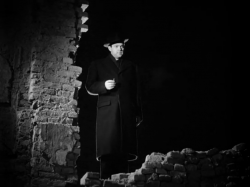 I have often puzzled over the last part of the film when Harry agrees to meet Holly. Does he not suspect that he is walking into a trap? Is it a kind of death wish? Or is his trust in Holly so absolute that it never occurs to him that he is being set up? The best defence I have read of Harry’s motivation at this point appears in a book on film-making by that great director Alexander Mackendrick, who, when a teacher at UCLA, had an exercise in which he invited his students to write out the thoughts of a screen character at a particular stage in a film: what would be going through that character’s mind? One of his main examples comes from The Third Man and the thoughts going through Harry Lime’s mind as he approaches that café. Mackendrick suggested a cluster of reasons for Harry’s keeping that appointment, including curiosity (and we know what curiosity did: it killed the cat), but at the heart of it is Harry’s absolute conviction of Holly’s enduring hero-worship and his capacity for loyalty, which makes him, in Harry’s eyes, completely trustworthy.14 “As though I’d do anything to you, or you to me…”
I have often puzzled over the last part of the film when Harry agrees to meet Holly. Does he not suspect that he is walking into a trap? Is it a kind of death wish? Or is his trust in Holly so absolute that it never occurs to him that he is being set up? The best defence I have read of Harry’s motivation at this point appears in a book on film-making by that great director Alexander Mackendrick, who, when a teacher at UCLA, had an exercise in which he invited his students to write out the thoughts of a screen character at a particular stage in a film: what would be going through that character’s mind? One of his main examples comes from The Third Man and the thoughts going through Harry Lime’s mind as he approaches that café. Mackendrick suggested a cluster of reasons for Harry’s keeping that appointment, including curiosity (and we know what curiosity did: it killed the cat), but at the heart of it is Harry’s absolute conviction of Holly’s enduring hero-worship and his capacity for loyalty, which makes him, in Harry’s eyes, completely trustworthy.14 “As though I’d do anything to you, or you to me…”
When Peter Bogdanovich discussed loyalty and betrayal with Welles and suggested that “you must disapprove then of Cotten’s betrayal of Harry Lime in The Third Man, Welles replied: “Of course… Betrayal is a big thing with me… almost a prime sin.”15 It is another aspect of the casting of Orson Welles which brings a resonance that would not have happened with any other actor. If there is one theme that recurs again and again in Welles’s work, it is the theme of betrayal and, more specifically, betrayal by one’s closest friend or confidante: from Citizen Kane (1941), Othello (1952) and Touch of Evil (1958) to perhaps the greatest betrayal scene in all literature, when Welles’s Falstaff is disowned by Prince Hal, now Henry V, in Chimes at Midnight (1966). And casting him next to Joseph Cotten, an acolyte from Welles’s Mercury Theatre, only intensifies the theme. Cotten as Jed Leland in Citizen Kane moans at one stage, “I was his oldest friend – and he behaved like a swine.” Did Cotten betray Welles over The Magnificent Ambersons (1942), Welles’s magnificent torso of a film, cut by the studio from 131 to 88 minutes after a disastrous preview, and in which Cotten appeared in some scenes that were re-shot by another director? Welles was very cross with him, but Cotten’s feeling was that, if he had not acquiesced, the film might not have been shown at all. Certainly the history between the two men feeds fascinatingly into the character complexities of The Third Man.
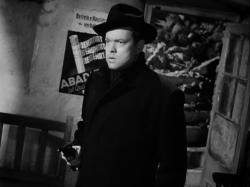 In one way, Holly exhibits a quality which Greene was to discuss controversially in his later career (notably in his defence of Kim Philby): the virtue of disloyalty. Holly is disloyal to Harry but for a virtuous reason: the sight of the “victims” in the children’s hospital. Yet why is it that this virtue feels so treacherous? In a later scene with Anna, when it seems as if her papers have been cleared, she realises that she is part of the bargain that Holly has struck with the police to trap Harry, and she tears up her papers in disgust. The price of her freedom is too high. “Look at yourself,” she says to Holly, “They have a name for faces like that.” We learn what that name is when she confronts Holly in the café just as Harry is stealing in by the back entrance and catches the end of their conversation. “Holly. What a silly name,” Anna is saying. “You must feel very proud to be a police informer [my emphasis].” It is on the word “informer” that Harry pulls his gun, and at that point his expression suggests he would do something to Holly, for this is the worst betrayal in his eyes. “Informer” was certainly a loaded word in the Hollywood of 1949, reeling from the investigations of the House UnAmerican Activities Committee and prior to the McCarthyist witch-hunts of the early 1950s, which will see friend informing on friend. Harry’s sentimental (complacent?) belief in Holly’s unwavering loyalty has proved his undoing.16
In one way, Holly exhibits a quality which Greene was to discuss controversially in his later career (notably in his defence of Kim Philby): the virtue of disloyalty. Holly is disloyal to Harry but for a virtuous reason: the sight of the “victims” in the children’s hospital. Yet why is it that this virtue feels so treacherous? In a later scene with Anna, when it seems as if her papers have been cleared, she realises that she is part of the bargain that Holly has struck with the police to trap Harry, and she tears up her papers in disgust. The price of her freedom is too high. “Look at yourself,” she says to Holly, “They have a name for faces like that.” We learn what that name is when she confronts Holly in the café just as Harry is stealing in by the back entrance and catches the end of their conversation. “Holly. What a silly name,” Anna is saying. “You must feel very proud to be a police informer [my emphasis].” It is on the word “informer” that Harry pulls his gun, and at that point his expression suggests he would do something to Holly, for this is the worst betrayal in his eyes. “Informer” was certainly a loaded word in the Hollywood of 1949, reeling from the investigations of the House UnAmerican Activities Committee and prior to the McCarthyist witch-hunts of the early 1950s, which will see friend informing on friend. Harry’s sentimental (complacent?) belief in Holly’s unwavering loyalty has proved his undoing.16
Extract 3: Chase, Funeral and Finale
 From the heights of Vienna to its depths: from the top of the Great Wheel to the sewers. Greene was fascinated by the sewers: what he called, “a strange world, unknown to most of us, that lies under our feet.”17 I suspect he saw people like that, essentially unknowable and with hidden depths; and the final chase does feel as if it represents the point when Lime is finally and inescapably trapped by the dark deviousness of his own personality.
From the heights of Vienna to its depths: from the top of the Great Wheel to the sewers. Greene was fascinated by the sewers: what he called, “a strange world, unknown to most of us, that lies under our feet.”17 I suspect he saw people like that, essentially unknowable and with hidden depths; and the final chase does feel as if it represents the point when Lime is finally and inescapably trapped by the dark deviousness of his own personality.
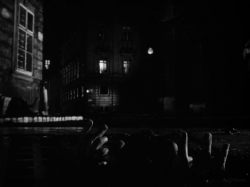
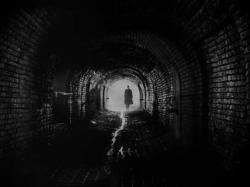
At the end, he is cornered, his bid for freedom now rendered as just fingers through a grating that lead out onto the street (another of the film’s indelible images). He has shot the sympathetic Sergeant Paine (Bernard Lee) and retribution is at hand. Now wounded, he will nod consent for Holly to shoot him, even at the end holding dominion over him and, as it were, calling the shots. There is a loud report; and Holly will come back down the tunnel alone with gun in hand, looking for all the world, and for the only time in the film, like one of those western heroes he writes about.
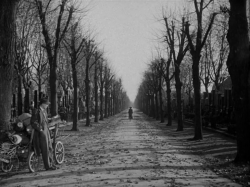 There follows a funeral scene which echoes how the film has begun and brings the narrative full circle (like the Great Wheel). What a strange narrative journey it has been: of a man investigating the suspicious circumstances of his friend’s death; suspecting he has been murdered but then discovering he is a murderer; and who, in a delicious stroke of irony that Harry himself might have appreciated, finds that finally it will fall upon him to kill the friend whose death he has been investigating. And yet is Harry dead really? His death is implied, not shown – like the ravages of his diluted penicillin. He still gets the girl, living on in the memory of Anna, who departs from the cemetery and walks past the waiting Holly without so much as a glance, leaving him on the margins of the film frame and amongst the falling leaves, sidelined in love, the absolute epitome of the forlorn romantic loser. Would audiences remain in their seats for this long goodbye and tolerate an unhappy ending in what had been intended as a film with, in Graham Greene’s words, no other desire than “to entertain them, to frighten them a little, to make them laugh”?18 Greene had misgivings, but Reed insisted that artistic truth should take precedence over commercial calculation, and he was triumphantly vindicated. As Greene later generously acknowledged, he had underestimated the mastery of Carol Reed’s direction and the potency of Anton Karas’s music in making the ending so perfect a conclusion.
There follows a funeral scene which echoes how the film has begun and brings the narrative full circle (like the Great Wheel). What a strange narrative journey it has been: of a man investigating the suspicious circumstances of his friend’s death; suspecting he has been murdered but then discovering he is a murderer; and who, in a delicious stroke of irony that Harry himself might have appreciated, finds that finally it will fall upon him to kill the friend whose death he has been investigating. And yet is Harry dead really? His death is implied, not shown – like the ravages of his diluted penicillin. He still gets the girl, living on in the memory of Anna, who departs from the cemetery and walks past the waiting Holly without so much as a glance, leaving him on the margins of the film frame and amongst the falling leaves, sidelined in love, the absolute epitome of the forlorn romantic loser. Would audiences remain in their seats for this long goodbye and tolerate an unhappy ending in what had been intended as a film with, in Graham Greene’s words, no other desire than “to entertain them, to frighten them a little, to make them laugh”?18 Greene had misgivings, but Reed insisted that artistic truth should take precedence over commercial calculation, and he was triumphantly vindicated. As Greene later generously acknowledged, he had underestimated the mastery of Carol Reed’s direction and the potency of Anton Karas’s music in making the ending so perfect a conclusion.
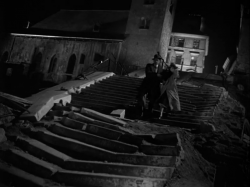
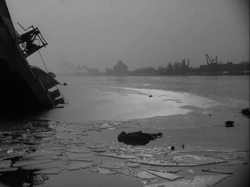
Although Greene said they had no desire to move people’s political emotions, it seems to me that, if T.S. Eliot’s The Waste Land is the definitive evocation of post-World War One decadence, demoralisation and dismay, then its equivalent artistic masterpiece of post-World War Two is The Third Man. With its own babble of languages and heap of broken images, and with its extraordinary visual deployment of a devastated Vienna to suggest a whole culture and civilisation in ruins, The Third Man quite transcends its thriller genre. At its heart stands Harry Lime, buried but seemingly imperishable, for he will soon be resurrected on radio and on television. With just a few lightning strokes of inspired creativity, Welles, Greene and Reed had fashioned an altogether extraordinary character who was realistic, symbolic, and mythical all at the same time.
This article is developed from a talk given for the Graham Greene International Festival.
Graham Greene, Ways of Escape (Penguin, 1980), pp. 181-182. ↩
The Pleasure Dome (Secker & Warburg, 1972), pp. 3-4. ↩
Peter Conrad, Orson Welles: The Stories of his Life (London: Faber & Faber, 2003), p. 329. ↩
Articles of Faith, edited by Ian Thomson (Signal Books, 2006), p. 146. ↩
Joseph Conrad’s Heart of Darkness was a work close to Greene’s heart also. As I have argued in Graham Greene: A Literary Life (Palgrave Macmillan, 2003), it has always seemed to me that the relationship between Holly Martins and Harry Lime owes its pattern to the Marlow/Kurtz relationship in the Conrad novella: “In both cases, one can see the attraction of the ostensibly ‘good’ character for the ostensibly ‘evil’ character, who makes him uncomfortably aware of darker potentialities within himself that he would rather not see. In Greene’s screenplay, Lime is the suppressed Dionysiac side of Martins’ inhibited personality, representing an outlawed vitality that Martins both envies and fears. Marlow has the same ambivalence towards Kurtz [Conrad’s phrase for this is “the fascination of the abomination”]. In both cases, the temptation of irresponsible licence that his ‘double’ represents is to be rooted out in a symbolic confrontation in darkness- in Conrad’s case, in the heart of the jungle; in Greene’s case, in the sewers of Vienna.” (p. 26) ↩
The Third Man screenplay (London: Faber & Faber, 1973), p. 63. ↩
Ibid., p. 95. ↩
After seeing the film, the great Hollywood director William Wyler had sent Carol Reed a spirit level, with a note that read: “Carol, next time you make a picture, just put it on top of the camera, will you?” See Nicholas Wapshott, The Man Between: A Biography of Carol Reed (Chatto & Windus, 1990), p. 228. ↩
André Bazin, Orson Welles: A Critical View (Elm Tree Books, 1978), p. 105 ↩
Graham Greene, Why the Epigraph? (Nonesuch Press, 1989). ↩
Graham Greene, Collected Essays (Penguin, 1970), p. 17. ↩
When Welles’s daughter Chris saw the film with her father and told him afterwards that she felt sorry for Lime at the end, he was delighted. “That’s what makes the movie work… and any other one, for that matter – that you can feel sympathy for the villain.” But when she asked him whether he liked Harry Lime, Welles replied: “Like him? I hate him. He’s utterly cold and without passion.” She says she was startled by the vehemence with which he spoke. See Chris Welles Feder, In My Father’s Shadow (Mainstream Publishing, 2009), p. 101. ↩
Peter Conrad, p. 357. ↩
See Alexander Mackendrick, On Film-Making, edited by Paul Cronin (London: Faber, 2004), pp. 55-7. ↩
Orson Welles and Peter Bogdanovich, edited by Jonathan Rosenbaum (Harper Collins, 1993), p. 296 ↩
The screenwriter William Rose once wrote that the basic theme of his screenplay for Alexander Mackendrick’s classic black comedy, The Ladykillers was: “In the Worst of all Men is a little bit of Good – that will destroy them”: see Mackendrick, On Film-Making, pp. 103-4. This could apply to the ending of Greene’s short story, “Across the Bridge” and is also applicable to Harry Lime. ↩
The Third Man screenplay, p.86. ↩
Graham Greene, ‘Preface’, The Third Man and The Fallen Idol (Penguin, 1971), p. 11. ↩
